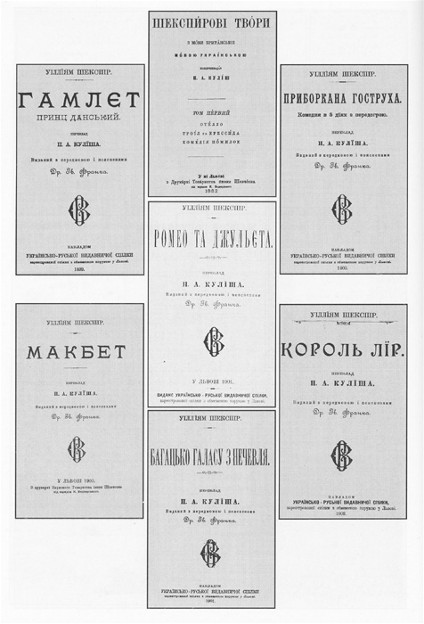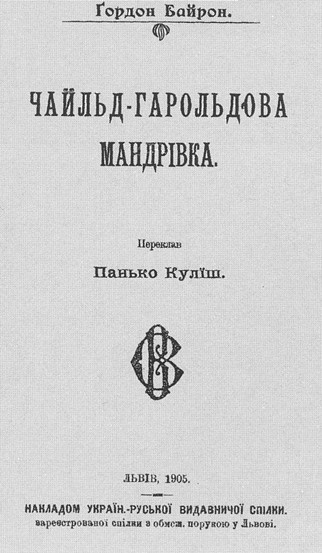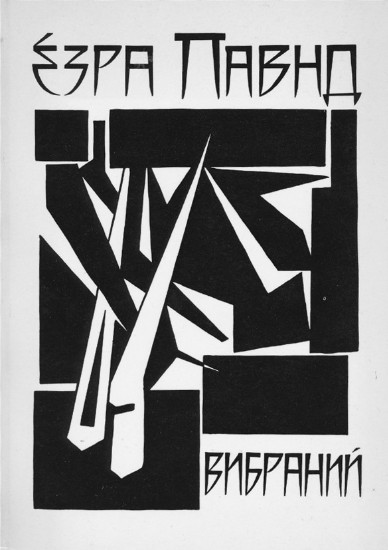Translated literature
Translated literature (перекладна література; perekladna literatura). As distinct from Ukrainian literature in translation, translated literature is literature translated into Ukrainian from other languages. The introduction of Christianity into Kyivan Rus’ (988; see Christianization of Ukraine) and the decision to forgo Greek in favor of Church Slavonic gave rise to translations of the Gospels and various texts necessary for religious celebration (the Epistles, Psalter, etc). Parallel and analogous to those translations were numerous collections of saints’ lives (prologues, Patericons) and collections of the works of the Fathers of the Church. Especially popular were the sermons of Saint John Chrysostom (Zlatostrui, Zlatoust) and other excerpts and aphorisms from the Bible, apocrypha, tales, and the like, collected in miscellanies, such as Pchela, in the Izbornik of Sviatoslav (1073) and Izbornik of Sviatoslav (1076), and in compendiums of the more wondrous and ‘scholarly’ nature, such as the chronicles of John Malalas, Georgios Hamartolos, and Georgios Synkellos. Also popular were translations of secular tales, such as Varlaam i Ioasaf, ‘Aleksandriia’, the Story of Troy, the Story of the Kingdom of India, and various historical compilations (eg, History of the Jewish Wars by Josephus Flavius). Such translated literature was typical of the 10th to 14th centuries and reached its high point during the reign of Yaroslav the Wise in the 11th century.
In the second half of the 14th century similar translations were common, but often they were no longer translations of the primary source but of Bulgarian or Serbian adaptations (eg, Zlataia tsip [Golden Chain] and Izmarahd [Emerald]). At that time translations of Latin tales appeared (via Poland and Bohemia), such as the stories of the Three Kings (the Magi) and new versions of the tales of Saint Alexis, of the ‘Aleksandriia’, and of the Trojan War. In the 16th and 17th centuries attempts were made at translations of the New Testament into Ukrainian and Belarusian (the Peresopnytsia Gospel, the Gospels of V. Tsiapinsky, Valentyn Nehalevsky [see Nehalevsky Gospel], and others). The Ostroh Bible appeared in Church Slavonic. In the 17th and 18th centuries tales of chivalry circulated either indirectly through Polish or Czech translations or directly from Italian (Tristan and Isolde, Prince Bova, the Seven Wise Men, Attila, Emperor Otto, and the like). All of those were reworkings far removed from the original and often adapted to specific Ukrainian customs. Simultaneously Giovanni Boccaccio’s Decameron became known in Ukraine, as well as Torquato Tasso’s Jerusalem Delivered (an adaptation from a Polish translation). Other translations of tales, anecdotes, and fables abounded. The translations were loose at best, most often transformations and adaptations. That type of adaptive translation finally led to Ivan Kotliarevsky’s travesty ‘translation’ of Virgil’s Aeneid.
In the first half of the 19th century translated literature in Ukraine followed Ivan Kotliarevsky’s success. Travesties of classical works were attempted by Petro Hulak-Artemovsky, Yevhen Hrebinka, Kostiantyn Dumytrashko, and Pavlo Biletsky-Nosenko. Even in the second half of the 19th century translation as ‘rendering in Ukrainian’ with elements of travesty continued in Stepan Rudansky’s Iliad (1872–7), in Petro Nishchynsky’s (P. Baida) Odyssey (1890), Iliad (1902–3), and Antigone (1883), and in the numerous translations by Oleksander Navrotsky. No longer travesties but far from real translations were the Ukrainianized versions done by the Romantics Levko Borovykovsky (poems of Aleksandr Pushkin, Adam Mickiewicz, Vasilii Zhukovsky), Amvrosii Metlynsky (German poems), Markiian Shashkevych (Serbian and Polish poems), and Mykola Kostomarov (George Byron and William Shakespeare). The artistic height reached in such transformational translation can be seen in Taras Shevchenko’s ‘Psalms of David.’
The pioneer of proper translations was Taras Shevchenko’s friend and contemporary Panteleimon Kulish. Translation became a prime activity of his mature life, as in his arduous translation of the Bible, which he began in 1868 with renderings of the ‘Psalms of David’ and completed only just before his death. The final edition of his translation of the Bible came out in 1903, with Ivan Puliui and Ivan Nechui-Levytsky as cotranslators. Kulish’s Shekspirovi tvory: Z movy brytans'koï movoiu ukraïns'koiu perekladav P. Kulish, T. I, Otello; Troïl ta Kressyda; Komediia pomylok (Shakespeare’s Works: From the British Language Translated into the Ukrainian Language by P. Kulish, vol 1, Othello; Troilus and Cressida; The Comedy of Errors) published by the Shevchenko Scientific Society in Lviv in 1882 was followed by translations of Byron’s Don Juan (1890–91), excerpts from Johann Wolfgang von Goethe, Heinrich Heine, and Johann Christoph Friedrich von Schiller (1885–6), and posthumous publications of other Shakespearean plays: Hamlet (1899), The Taming of the Shrew (1900), Macbeth (1900), Coriolanus (1900), Julius Caesar (1901), Romeo and Juliet (1901), Much Ado about Nothing (1901), Antony and Cleopatra (1901), Measure for Measure (1902), and King Lear (1902). All the posthumously published translations of William Shakespeare’s plays were edited and introduced by Ivan Franko, who also contributed to the store of translated literature by translating over 60 authors (Sappho, Sophocles, Horace, Ovid, Miguel de Cervantes, Dante, Emilé Zola, Gustave Flaubert, Victor Hugo, Paul Verlaine, Goethe, Heine, Shakespeare, Byron, Robert Burns, Mark Twain, Nikolai Gogol, Vladimir Solovev, Adam Mickiewicz, Jan Neruda, Karel Havlíček-Borovský, Henrik Ibsen, August Strindberg, and many others).
Others who worked in the field of translation at the beginning of the 20th century were Volodymyr Samiilenko (one song of the Iliad [1887], the ‘Inferno’ from Dante’s Divine Comedy [1892–1902], some Molière, Bret Harte, Byron, Pierre-Jean de Béranger, and other authors), and Lesia Ukrainka (Heine’s Buch der Lieder [1892], translated with M. Stavysky [Maksym Slavinsky], some of Nkolai Gogol, Ivan Turgenev, Hugo, Gerhard Hauptmann, and Maurice Maeterlinck). Quite prolific as translators were Pavlo Hrabovsky (Byron’s Childe Harold’s Pilgrimage [1895], Edgar Allan Poe’s ‘Raven’ [1897], some poems by Alfred Lord Tennyson, and about 270 poems by other poets) and Mykhailo Starytsky (Tales of Hans Christian Andersen [1873], Ivan Krylov’s Fables [1874], Serbian epic songs [1876], and poems by Aleksandr Pushkin, George Byron, Heinrich Heine, Adam Mickiewicz, and others). Vasyl Shchurat’s translation of the 11th-century French epic Chanson de Roland (1895) has yet to be surpassed and has been republished (1957, 1962). Shchurat also adapted into contemporary Ukrainian the Old Ukrainian epic Slovo o polku Ihorevi (The Tale of Ihor’s Campaign, 1907) and translated works by many authors, such as Sándor Petőfi, Kazimierz Przerwa-Tetmajer, Juliusz Słowacki, Nikolai Nekrasov, Sergei Aksakov, Pushkin, Poe, and Hugo. Ahatanhel Krymsky translated from Persian, Turkish, Arabic, Russian, and German. Translation into Ukrainian was also part of the program of the literary group Pleiada. In Ukraine under Russian rule translating activity was greatly hindered by the Ems Ukase (1876), which prohibited the printing and distribution of all Ukrainian-language original and translated works. As a result translated works could be published only in Galicia or Bukovyna.
In Western Ukraine in the first decades of the 20th century, translated literature was much in vogue in such publications as the magazine S’vit, the magazine of the modernists Moloda Muza, and in the series Biblioteka naiznamenytshykh povistei (The Library of the Best Novelettes, 74 vols), published by the newspaper Dilo. The quality of the translations in that series was poor because works were often translated from Polish, Russian, or German translations of the original text. Much more precise were the translations published by the Ukrainian-Ruthenian Publishing Company under the editorship of Ivan Franko, Volodymyr Hnatiuk, and Mykhailo Hrushevsky. Through the efforts of the editors as well as other contributors (eg, Petro Karmansky, Yevhen Tymchenko, O. Cherniakhivska, Ivan Krevetsky) many works from various literatures appeared in Ukrainian translation. In addition to the Finnish epic Kalevala (translated by Tymchenko, 1901) and the plays by William Shakespeare (translated by Panteleimon Kulish) the company published translations of the works of Guy de Maupassant, Knut Hamsun, Henrik Pontoppidan, Gerhard Hauptmann, Vladimir Korolenko, Karl Gutzkow, Władysław Orkan, Karel Havlíček-Borovský, Heinrich Heine, Maxim Gorky, Anton Chekhov, Emilé Zola, George Byron, Leo Tolstoy, Upton Sinclair, and others. A similar contribution to translated literature came from Literaturno-naukovyi vistnyk, which systematically published good translations of world classics and contemporary works. The Novitnia biblioteka (New Library) book series, published in Lviv 1912–23 and edited by Fed Fedortsiv, included many of the aforementioned works and also the works of Leonid Andreev, Stanisław Żeromski, Edgar Allan Poe, Anatole France, and E.T.A. Hoffmann. Ukrainska Nakladnia (a publishing house established as Halytska Nakladnia in 1903 by Yakiv Orenshtain) published the works of Aesop, Jean de La Fontaine, Friedrich Nietzsche, Rudyard Kipling, Bjørnstjerne Bjørnson, Henrik Ibsen, and others in the Zahalna biblioteka (General Library) book series. The publishing house Vsesvitnia Biblioteka, founded by Ivan Kalynovych in 1913–14 in Lviv and Zolochiv, published the works of Johann Christoph Friedrich von Schiller, Johann Wolfgang von Goethe, and Aleksandr Pushkin, which were translated and edited, for the most part, by Ivan Franko.
Translating activity increased after the hiatus created by the First World War, although neither was the activity planned nor was the translation always from original languages directly into Ukrainian. Some translations done by the better translators from the prewar years were the exception. Most notable were Volodymyr Samiilenko’s translation of Molière’s Tartuffe (1917) and stories by Vicente Blasco Ibáñez (1926) and Khrystia Alchevska’s translations of Victor Hugo. Although many authors engaged in sporadic translation, there were several who excelled, and whose activity greatly contributed to the store of translated literature. The Neoclassicists were all engaged in translation. Pavlo Fylypovych translated mainly from Russian poets (eg, Aleksandr Pushkin, Valerii Briusov, and Evgenii Baratynsky). Mykhailo Drai-Khmara, in addition to translating Russian (eg, Pushkin, Mikhail Lermontov) and Czech (Josef Machar, Josef Hora) poets, translated the Belarusian poet Maksym Bahdanovich (Vinok [Wreath, 1929]). His work on the Kalevala and the Divine Comedy was interrupted by his arrest. Yurii Klen (then still Oswald Burghardt) translated primarily German but also French and English poetry (eg, Zalizni sonety [Iron Sonnets, 1926]). Mykola Zerov translated the sonnets of the French poets José-Maria de Heredia and Charles Marie René Leconte de Lisle, and Juliusz Słowacki’s Mazepa (staged in 1922). He collaborated with Fylypovych and Maksym Rylsky on the translations of Pushkin (his translation of Boris Godunov appeared in 1937 under the name of B. Petrushevsky) but concentrated mainly on Latin poets (Antolohiia ryms'koï poeziï [Anthology of Roman Poetry, 1920]) Rylsky was the most prolific of the Neoclassicist translators. He translated throughout his life and is credited with rendering works from more than 20 literatures into Ukrainian, among them Belgian (Charles Van Lerberghe’s Pan [1918], Maurice Maeterlinck), French (Théophile Gautier, José-Maria de Heredia, Paul Verlaine, Stéphane Mallarmé, Francis Jammes, Henri de Régnier, Joseph Bédier’s adaptive translation of the medieval Le Roman de Tristan et Iseult [1928; 3rd edn 1972], Guy de Maupassant, Gustave Flaubert’s Salammbô, Pierre Corneille’s Le Cid [1931], Molière's Le Misanthrope [1931], Jean Racine’s Phèdre [1931], Nicolas Boileau’s L’art poétique [1931], Voltaire’s La pucelle d’Orléans [1934], Edmond Rostand’s Cyrano de Bergerac [1947]), English (William Shakespeare’s King Lear and Twelfth Night [1958]), Armenian (Sayat-Nova, Avetik Isaakian), Georgian (Galaktion Tabidze), Belarusian (Yanko Kupala, Yakub Kolas), Russian (Mikhail Lermontov, Fedor Tiutchev, Afanasii Fet, Aleksandr Blok, and most of Aleksandr Pushkin), Polish (primarily Adam Mickiewicz but also Juliusz Słowacki, Kazimierz Przerwa-Tetmajer, Julian Tuwim, Cyprian Kamil Norwid). Rylsky’s translation of Mickiewicz’s Pan Tadeusz (first version published in 1927, but reworked several times during Rylsky’s life) was awarded the prize of the Polish PEN club for the mastery of the translation in 1949.
Other important translations were Dmytro Zahul’s from German literature (Heinrich Heine [1918–19], Johann Wolfgang von Goethe’s Faust [1925], Johann Christoph Friedrich von Schiller’s ballads [1927], German ballads [1929]), Ivan Kulyk’s Antholohiia amerykans'koï poeziï (Anthology of American Poetry, 1928), Volodymyr Svidzinsky’s comedies of Aristophanes (1939), and Mykola Bazhan’s translations from Armenian and Georgian, most notably of Shota Rustaveli’s The Knight in the Tiger Skin (1937). Valeriian Pidmohylny concentrated on translating French prose (eg, Anatole France’s stories [1925], Thaïs [1927], La rôtisserie de la Reine Pédauque [1929]—he also edited the first 8 vols of a 24-volume collection of France’s works [1930]—Voltaire’s Candide [1927], Prosper Mérimée’s Colomba [1927], Honoré de Balzac’s Le Père Goriot [1927], Les parents pauvres [1929], Guy de Maupassant’s Fort comme la mort, Bel-Ami, and Mont-Oriol [published separately and as part of the 10-vol works, 1928–30], and Denis Diderot [2 vols, 1933]). Mykola Tereshchenko’s lifelong interest in translating French poetry began with his volume of Emil Verhaeren’s verse (1927) and culminated in the posthumous publication of the anthology of French verse Suzir’ia frantsuz'koï poeziï (The Constellation of French Poetry, 2 vols, 1971).
Devoted specifically to literary translation were translators such as M. Ivanov (Cervantes’s Don Quixote [1927], some Charles Dickens, Rudyard Kipling, Mark Twain, Arthur Conan Doyle [2 vols in 1928], and other works), H. Kasianenko (some Joseph Conrad, Arthur Conan Doyle, John Dos Passos, and Jack London), and K. Lubensky (Aristophanes’ Lysistrata [1928]). The flurry of translation activity included the founding of Vsesvit in 1925, a journal dedicated to opening worldwide literary horizons. During the Stalinist terror of the 1930s the wholesale destruction of Ukrainian cultural life also brought an end to most of the translation activity. Only a trickle continued. The most notable translations were an anthology of world literature (of which only the third volume was published, 1931) and an anthology of ancient literature (1938), both edited by Oleksander Biletsky, in which, indicative of the times, the names of repressed translators (eg, Mykola Zerov, Valeriian Pidmohylny, Ivan M. Steshenko, and Dmytro Zahul) were intentionally left out. The increased interest in Spain resulting from the Spanish Civil War there justified some translation of Spanish poetry, but on the whole only pro-Soviet authors were translated. The only regular translation activity before the Second World War consisted of translation from the literature of the various nationalities in the Soviet Union, from Russian in particular.
In Western Ukraine and among émigrés, however, translation activity continued between the two world wars. Translations, mainly from classical, Old Ukrainian, French, Scandinavian, Italian, and English literature, were done by authors such as Oles Babii, Sviatoslav Hordynsky, Petro Karmansky, Mykhailo Rudnytsky, Vasyl Levytsky-Sofroniv, and Vasyl Shchurat. Of special note were the editions from Yakiv Orenshtain in Berlin in the Zahalna biblioteka book series and in separate volumes of translations of George Bernard Shaw, Arthur Schnitzler, Plato, Frédéric Mistral, Anatole France, Romain Rolland, and Vladimir Korolenko. From 1921 to 1924 the Chaika publishing house in Vienna, under the editorship of Ostap Hrytsai, published 13 volumes of translations done by Valeriia O’Connor-Vilinska, Mykola Shrah, Nadiia Surovtsova, B. Chorny, Mykola Trotsky, and S. Pashchenko of Hugo, Gautier, Dickens, Alphonse Daudet, Georg Ebers, de Maupassant, Alfred de Musset, Stendhal, Leo Tolstoy, and Flaubert.
The end of the 1950s, after the 20th Congress and Nikita Khrushchev’s ‘thaw,’ brought about the revival of Vsesvit, in 1958, with a mandate to introduce its readers within the Soviet Union to foreign literature. Foremost translators who had made their debuts in the 1930s and had managed to survive the Stalinist terror now came forth with excellent translations. Borys Ten, who published his translation of Aeschylus’ Prometheus Bound in 1949 and the comedies of Aristophanes in 1956, made his greatest contribution in his translations of Homer’s Odyssey (1963) and Iliad (1978). Iryna Steshenko concentrated on drama and translated comedies by Molière and Carlo Goldoni, several plays by William Shakespeare (in the 3-vol edn of 1964), Johann Wolfgang von Goethe’s Egmont, Johann Christoph Friedrich von Schiller’s Don Carlos, Fernand Crommelynck’s Tripes d’or, and Georg Buchner’s Wozzeck. Vasyl Mysyk became a leading translator of English, American, German, and Persian literature, in particular of the poetry of Robert Burns (1932), Rudaki (1962), Omar Khayyám (1965), John Keats (1968), Hafez (1971), and Firdousi (1975). Yevhen Drobiazko translated from Russian, French (particularly Honoré de Balzac and Molière), German (eg, Heine, Goethe, Schiller), and Polish (Juliusz Słowacki and Julian Tuwim). His greatest achievement was a full translation of Dante’s Divine Comedy in 1976.
The 1960s in Ukraine saw an outburst of literary activity of the Shistdesiatnyky generation, including a renewed interest in translations. New translators appeared, such as Oleksander Terekh, R. Dotsenko, Anatolii Perepadia, Yevhen Popovych, Oleksandra Seniuk, M. Pinchevsky, V. Mytrofanov, and Yu. Lisniak. They gathered around Vsesvit, where the first translations of Franz Kafka, William Golding, Ernest Hemingway, William Faulkner, and other modern authors appeared. The decade also marked the first of the translations of two master translators, Mykola Lukash and Hryhorii Kochur. The two collaborated on a translation of Paul Verlaine’s poetry in 1968. The appearance of Boccaccio’s Decameron in 1964, (repr 1969 and 1985, translated by Lukash with proper rendition in Ukrainian of the nuances of Boccaccio’s language, was a cultural landmark in the struggle for the development of the Ukrainian language under the constant pressure of Russification. At that time the works of Jack London appeared in 12 volumes, including translations done in the 1920s by repressed translators. The eight volumes of Guy de Maupassant (1969–72) also included translations done by Valeriian Pidmohylny. Translations of children's literature, outside of the normal fairy tales, legends, and myths, were published by the Veselka publishing house; Braty Maugli (1967), a translation of Rudyard Kipling’s The Jungle Book, is an example.
In the 1970s, however, new waves of repression began against Ukrainian culture, including literature and translation. The use of dialectal words, especially from Western Ukraine, was deemed a subversive act by which the translator was attempting to keep the Ukrainian language from a ‘merger with the brotherly Russian tongue.’ Mykola Lukash and Hryhorii Kochur were expelled from the Writers' Union of Ukraine. R. Dotsenko and Anatolii Perepadia were especially persecuted for the use of dialectal words and were prevented from working. The editor of Vsesvit, Dmytro Pavlychko, was removed in 1978, and the journal itself was severely criticized. Yet some translations continued to appear, of François Villon (1973) by Leonid Pervomaisky and of Rainer Maria Rilke (1974) by Mykola Bazhan. Only Bazhan’s personal authority prevented complete censorship of his translation, which was severely criticized. Other noteworthy translations that appeared at that time were volumes of works by Anatole France (4 vols, 1976–7), Bolesław Prus (5 vols, 1978–9), and Ernest Hemingway (4 vols, 1979–81), Heinrich Hesse’s Das Glasperlenspiel (translated by Yevhen Popovych and Lina Kostenko, 1978 and 1983), John Galsworthy’s The Forsyte Saga (translated by Oleksander Terekh, 1976; repub 1982, 1988), Daniel Defoe’s Robinson Crusoe (1965; repub 1976, 1978, and 1985), Louis Carroll’s Alice’s Adventures in Wonderland (translated by H. Bushyn, 1976), Johnathan Swift’s Gulliver’s Travels (translated by Yu. Lisniak, 1976; repub 1983), Kurt Vonnegut’s Slaughterhouse Five (translated by P. Sokolovsky, 1976), H.G. Wells’s War of the Worlds and other novels (translated by Dmytro Palamarchuk and M. Ivanov, 1977), Truman Capote’s collection (translated by V. Mytrofanov, 1977), James Baldwin’s If Beale Street Could Talk (translated by L. Honchar, 1978), works by William Faulkner (translated by R. Dotsenko, 1978) and Evelyn Waugh (1979), Joyce Carol Oates’s collection of stories (1979), Aristophanes’ comedies (a reissue of the translations by Borys Ten and Volodymyr Svidzinsky, and new ones by Andrii Sodomora, 1980), and Charlotte Brontë’s Jane Eyre (translated by P. Sokolovsky, 1971; repub 1983 and 1987). Yet Guillaume Apollinaire’s poetry as translated by Lukash in the 1970s had to wait untill 1984 to be published. With the fall of Leonid Brezhnev, the situation began to improve. Lukash’s unique talents as a master translator were recognized with the establishment of a translation prize in his name in 1989 for the best translation in a given year to appear in Vsesvit (the first recipient was V. Shovkun, for his translation of Gore Vidal’s Creation). Lukash died before finishing his translation of Cervantes’s Don Quixote, which was being finished by A. Perepadia.
Interest in South American literature produced translations of the works of José Amado, Julio Cortázar, Mario Vargas Llosa, Gabriel García Marquez, Jorge Louis Borges, Alejo Carpentier, and others. Of special significance was a six-volume edition of William Shakespeare (1983–6), in which the best of both previous and new translations were collected. The 1980s produced some notable translations, among which the following stand out: an anthology of Greek tragedies (translated by Borys Ten, 1981), the tragedies of Sophocles (by Ten and Andrii Sodomora, 1989), two volumes of Gustave Flaubert (1987), Ovid’s Metamorphoses (by Sodomora, 1985), E.T.A. Hoffmann's stories (by Yevhen Popovych, 1987), Pär Lagerkvist’s Mariamna (by O. Seniuk, 1988), Luís de Camões’s Os Lusíadas (by M. Lytvynets, 1987), Francis Scott Fitzgerald’s The Great Gatsby (by M. Pinchevsky, 1982), William Thackeray’s Vanity Fair (by O. Seniuk, 1983), Herman Melville’s Moby Dick (by Yu. Lisniak, 1984), George Byron's Don Juan (by Sava Holovanivsky, 1985), Joseph Conrad’s Lord Jim (by L. Honchar, 1985), and J.R.R. Tolkien’s The Hobbit (by Oleksandr Mokrovolsky, 1985). Of interest was the series Svitova proza 20 st. (World Prose of the 20th century), established in 1988, in which works such as Joseph Heller’s Catch 22 (1988), John Updike’s The Centaur of the Farm (1988), and William Somerset Maugham’s The Moon and Sixpence and The Razor’s Edge (1989) appeared. In 1990 an edition of Aeschylus’ Tragedies was published (cotranslated by Andrii Sodomora and Borys Ten).
The numerous professional translators in Ukraine form a school of literary translation; at that time the most important translator was Hryhorii Kochur. But translation also continued to be done by literary scholars specializing in various foreign literatures, such as Dmytro Zatonsky, T. Denysova, K. Shakhova, Yurii Pokalchuk, Oksana Pakhlovska, Solomiia Pavlychko, and V. Kukhalashvili. There was a special commission at the Writers' Union of Ukraine for translations of literature. Most translated works were published by the Dnipro publishing house, where several book series were established, such as Biblioteka svitovoi klasyky (World Classics Library, since 1967), Perlyny svitovoi liryky (Pearls of World Lyric Poetry, since 1965), and Svitova proza 20 st. (World Prose of the 20th Century, since 1988). In 1990 Dnipro published an edition of selected poems by T.S. Eliot (several translators; edited by Pavlychko). Important work in the theory of literary translation has been done by Maksym Rylsky, Oleksii Kundzich, Yosyp Bahmut, Borys Ten, Z. Bilenko, Stepan Kovhaniuk, and Hryhorii Kochur. Since 1972 a yearly bibliographic survey of translations into Ukrainian has been provided by the journal Vsesvit.
Translation has also continued in the emigration since 1945, mainly in drama and poetry. Translations were done mostly by authors who augmented their own literary output with translations. Most prolific was Mykhailo Orest, who translated Stefan George (1952), Max Dauthendey (1953), Rainer Maria Rilke, Hugo Hofmannsthal, and Charles Marie René Leconte de Lisle (1956), and prepared anthologies of German (1954), French (1954), and European poetry (including Italian, English, Spanish, Portuguese, Russian, and Polish, 1959) and a collection of German novellas (1962). Vira Vovk prepared an anthology of Portuguese and Brazilian poetry, Zelene vyno (Green Wine, 1964), Sviatoslav Hordynsky compiled Poety zakhodu (Poets of the West, 1961), and Wolfram Burghardt edited Poeziia Kvebeku (Poetry of Quebec, 1972). Vovk and Burghardt collaborated on Four Plays of F. Garcia Lorca (1974). Ihor Kostetsky did much to expand the store of translations into Ukrainian and his publishing house, Na Hori, published some of the finest translations in the postwar emigration: selected poems of Federico García Lorca (edited by Kostetsky and translated by members of the New York Group, 1958); T.S. Eliot’s Murder in the Cathedral (translated by Zenon Tarnavsky, 1963); Stefan George’s two volumes, rendered into Ukrainian and other Slavic languages by Kostetsky and Oleh Zuievsky (1968–71); Paul Claudel’s L’Annonce faite à Marie (translated by Marta Kalytovska, 1962); selections of Ezra Pound (by Kostetsky, 1960), and William Shakespeare’s Macbeth, Henry IV (by Teodosii Osmachka, 1961), and King Lear (by Vasyl Barka, 1969). Ivan Koshelivets translated Denis Diderot’s Jacques le fataliste et son maître (1970) and Franz Kafka’s stories (1989). Selected poems of John Keats were translated by Yar Slavutych (1958), some Japanese haiku by Ihor Shankovsky (1966), and Samuel Beckett’s Waiting for Godot and Krapp’s Last Tape by Bohdan Boychuk (1972). An interesting collaboration between émigré poets and poets from Ukraine is the translation of Stanley Kunitz’s This Garland, Danger (1977), in which Boychuk, Wolfram Burghardt, Ivan Drach, Vadym Lesych, and Yuriy Tarnawsky collaborated.
BIBLIOGRAPHY
Mezhenko, Iu.; Iashek, M. ‘Chuzhomovne pys'menstvo v ukraïns'kykh perekladakh,’ ZhR, 1929, nos 4–8
Rodzevych, Serhii. ‘Novyny perekladnoï literatury,’ ZhR, 1928, nos 9,11; 1929, nos 1, 3–5, 11; 1930, no. 4; 1931, no. 7
Derkach, B. Perekladna ukraïns'ka povist’ XVII–XVIII stolit' (Kyiv 1960)
‘Zarubizhna literatura na Ukraïni,’ Vsesvit, 1960, no. 10
Kravtsiv, Bohdan. ‘Poeziia Zakhodu v ukraïns'kykh perekladakh,’ Suchasnist’, 1962, no. 4
Kushch, O. Rosiis'ka literatura v ukraïns'kykh perekladakh i krytytsi: Halychyna i Bukovyna XIX st.–1939 (Kyiv 1963)
Kochur, Hryhorii. ‘Na perekladnyts'ki temy,’ Dnipro, 1965, no. 6
———, ‘Maistry perekladu,’ Vsesvit, 1966, no. 4
———, ‘Zdobutky i perespektyvy,’ Vsesvit, 1968, no. 1
‘Zarubizhna literatura na Ukraïni,’ Vsesvit, 1972, no.1; 1973, no.1; 1974, no. 1; 1975, no. 1; 1976, no. 1; 1977, no. 4; 1978, no. 5; 1979, no. 7; 1980, no. 6; 1981, no. 6; 1982, no.6; 1983, no. 6; 1984, no. 6; 1985, no. 6; 1986, no. 10; 1987, no. 6; 1988, no. 7
Kachurovs'kyi, I. ‘Perekladachi ukraïns'koï diaspory,’ Vsesvit, 1991, no. 11
Strikha, Maksym. Istoriia i s'ohodennia ukraïns'koho poetychnoho perekladu (XII–XX st.) (Lviv 2002)
Strikha, Maksym. Ukraïns'kyi khudozhnii pereklad: Mizh literaturoiu i natsiietvorenniam (Kyiv 2006)
Kolomiiets', Lada. Ukraïns'kyi khudozhnii pereklad ta perekladachi 1920–30-kh rokiv (Vinnytsia 2015)
Bohdan Kravtsiv, Yurii Pokalchuk, Danylo Husar Struk
[This article originally appeared in the Encyclopedia of Ukraine, vol. 5 (1993).]
 headpiece.jpg)
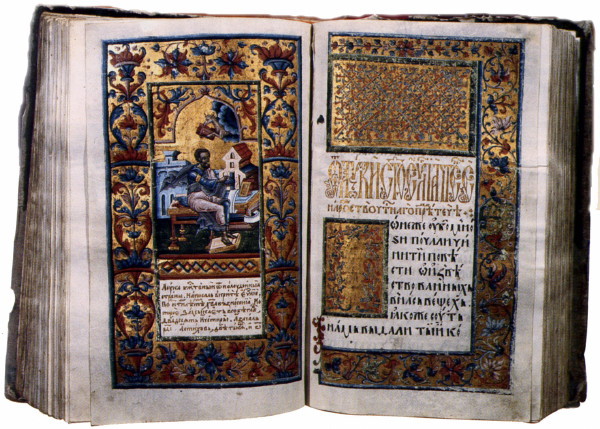
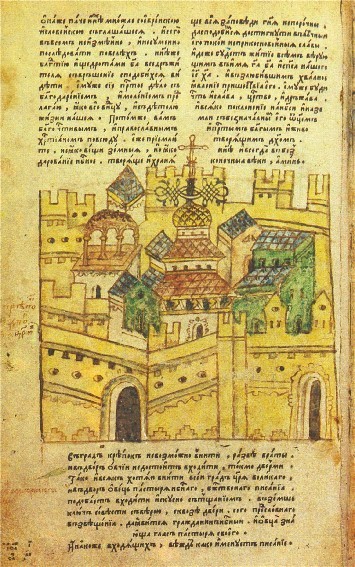
.jpg)
.jpg)
